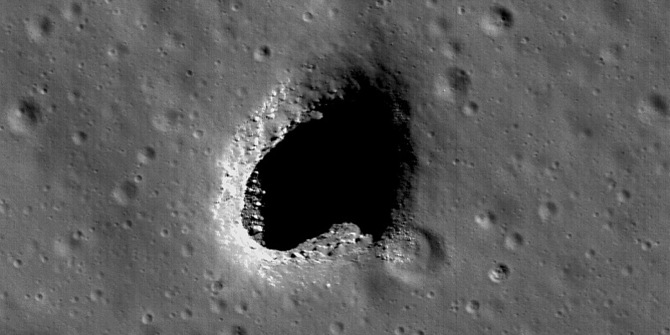 A robot descends slowly into a “skylight” on the Moon, the gateway to a lunar cave network sheltered from the harsh thermal environment and micrometeorites showering the surface. Its goal: to scout and construct habitats suitable for human beings.
A robot descends slowly into a “skylight” on the Moon, the gateway to a lunar cave network sheltered from the harsh thermal environment and micrometeorites showering the surface. Its goal: to scout and construct habitats suitable for human beings.
“Three locations have been found which have skylights on the order of 100 meters across,” says Astrobotic Technology Inc.’s President John Thornton.”It’s a good parallel to where humans settled on earth. They chose caves because they provided shelter and protection.”
Astrobotic’s mission is to provide cost-effective landers and roving robots for planetary missions.”The Moon is a first step in human beings learning to live off beyond the Earth,” Thornton continues. “It’s very important to the future of mankind to expand beyond our home planet: to satisfy our innate curiosity, for exploration and potentially for survival should we damage this Earth beyond repair.”
To survive on another planet, we would need a reliable water supply, food, basic manufacturing facilities like 3D printers to make spare parts or new machines, and robots for exploration and transport. In October 2015, Astrobotic will send a lander and rover to the Moon to search for the most basic of those requirements: water.
Water is an almost magical chemical whose components can be used to make everything from air for breathing to rocket fuel. Procuring water and making fuel locally could dramatically cut the cost of planetary exploration, since currently all resources are carried from Earth at a cost of million of dollars per kilo.
Astrobotic’s robot rover Polaris will hitch a ride on a Falcon 9 rocket launched by SpaceX. After landing, it will prospect for polar ice and determine how to harvest it. The rover has three vertical solar panels to generate 250W of power, stereo cameras and laser to generate 3-D video and models of the surface and for navigation. Polaris can drive and avoid obstacles autonomously.
The polar mission is also an attempt to win Google’s Lunar X prize, a $20 million reward for the first privately-funded robot to land on the surface of the Moon, drive 500 meters and send video and images back to Earth. There are bonus prizes for other robotic feats like driving 5 km or surviving 14 frigid lunar nights (at liquid nitrogen temperatures) intact. While most X-prize entries are small-scale, Astrobotic will bring 100kg of payload to the Moon and the company sees it as just a first step in lunar colonization and commercialization.NASA cancelled its manned lunar space program last year so future manned lunar exploration is now the domain of private industry.
The first lunar industry may be mining. “The Moon could be a potentially huge source of a lot of exotic materials,” Thornton explained. “It has platinum. It has Helium-3, a third generation, nuclear fusion fuel which creates no radiation as a byproduct. It comes from solar wind and doesn’t occur naturally on Earth.”
To mine, you need permanent settlements suitable for human beings. That’s where the caves come in. Robots could prepare landing sites, find new caves, map the cave network, construct infrastructure for returning to those caves and finally create habitats for humans. “Most of the technology is there,” said Thornton. “There are some issues we are focusing on like precision landing with an accuracy of 10s of meters. That’s important when you want to return to same place. There will be a new type of robot to descend down into the cave the first time and then set up the infrastructure to access it regularly.”
Astrobotic’s first customers are, however, the space agencies themselves. The company is developing robotic equipment for NASA and will haul payload from space agencies and scientific institutions to the Moon. Later, space agencies may even buy tickets for their astronauts. Thornton claims that the role of the commercial sector is to take established space technology and put it into an affordable form, while government agencies should continue to push the boundaries.
It’s not all about the money though, even for commercial space companies. “One of the most important things about space exploration is exciting a new generation about space,” Thorton muses. “It’s been 40 years since Apollo landed on the surface of the Moon. How many young people were inspired at that time to become scientists or engineers or the next astronaut? We have lost a bit of that. If we can revive interest in the Moon it’s a first step towards reinvigorating the next generation and that’s important to the future of all of us.”
VentureBeat's mission is to be a digital town square for technical decision-makers to gain knowledge about transformative enterprise technology and transact. Learn More

